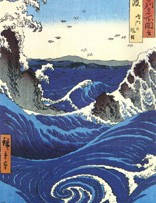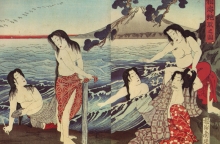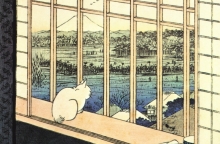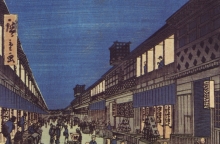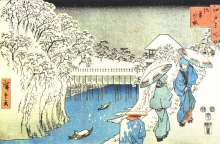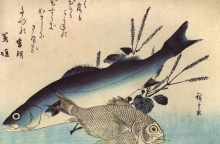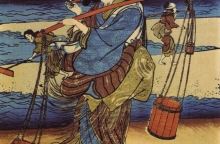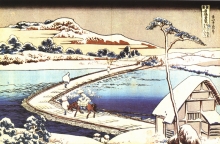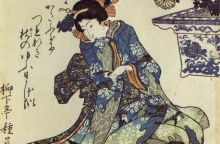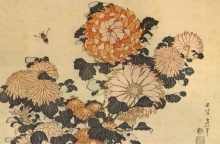Giverny | Collection of japanese prints of Claude Monet
(HIROSHIGE HITSU – Sights of the swirls from Naruto to Awa) Claude Monet’s impressive collection of Japanese prints includes two hundred and thirty one engravings. Although not seen (?) for a number of years, following it’s donation by his son Michel Monet, the collection was placed in the home of the painter in Giverny, restored thanks to the efforts of Mr. Gerald van der Kemp and the generous friends of the Institut of France. Visitors of Giverny are often surprised that there are not many paintings by the master himself but rather some reproductions of his work.His painting are indeed dispersed today between French museums, in particular Marmottan and the Jeu de Paume, foreign museums and private collections. And Giverny, in that sense, reflects the man that was Monet more than his pictorial work.
This revelation is instrumental in setting the tone for visitors and serves as an excellent introduction to the subject. In this beautiful and lush area this very rich collection of Japanese engravings already came as a surprise to many of the impressionist innovator’s friends.
Let’s use our imagination as a time machine and think that we are feeling today, what people like Marc Elder, the Trevise Duke or Gustave Geoffroy perceived a hundred years ago. This dining room with the panels painted in pale yellow, enhanced by the mouldings of a bright yellow, with the pieces of furniture, sideboards, cupboards, painted in the same way, decorated on all the walls with a profusion of Japanese prints, simply placed under a glass, the most beautiful, rarest, from Korin and Harunobu to Hokusal and Hiroshige; and most unexpected too, where the Japanses art of the Japanese victoriously applied to represent the costumes and the aspects of the Dutch life in the colonies.
It was in 1883 that Monet fell in love at first sight for this charming house that he discovered during a walk. He lived in it until his death, in 1926. During this long period, the painter arranged the house indefatigably, added workshops and a greenhouse, and devoted much time to his garden.. These changes and his determination to improve the garden, to change its colors, indicates his strong desire to paint and repaint some of his paintings, in search of an absolute which exceeds painting,
The Water Lilies and their many versions stand in counterpoint, curiously separated from this garden by a small bridge, by chance Japanese. Residence, garden, prints can thus be perceived, parallel to the work of the painter, like epiphenomenons of a rich, original personality and constantly on the move.
Comparison with painters’ collections of Japanese prints
Above all the collection of Monet presents an historical interest, as it is, like those of Vincent van Gogh and Auguste Rodin rather kept in its unity. If many other painters, from Bracquemond to James Mac Neil Whistler, from Henri de Toulouse-Lautrec to Pierre Bonnard gathered, by inclination or by artistic affinity, ukiyo-e engravings, none of these collections made it to us in its full unity. Among the impressionists close to Monet, Edgar Degas and Camille Pissarro were captured by the charm of the Japanese artists, particularly of Utamaro, and the latter had about ten plates, for example the {Portrait of an young woman wiping a plate} and {Morokochi from the house Echizenya}.
The collection of Japanese prints of Degas is more familiar to us because the catalogue of a posthumous sale, November 6th and 7th 1918, mentions a batch of engravings made up of Kiyonaga (the Bath of the women), of Utamaro (two triptychs), of Hokusai, Toyokuni and about forty plates of Hiroshige as well as two albums of Sukenobu.
Simply listing these names of artists, we note the attraction of Degas for the large Masters of Japanese engraving and especially for those of the 18th century.
Japanese prints of Vincent van Gogh, permanently hung in the Vincent van Gogh Museum of Amsterdam like those of Monet in Giverny, offer an artistic panorama of 19th Japanese where the courtesans and the portraits of actors of Kunisada prevail, as well as Kuniyoshi and Yoshitora, artists who also appear in the collection of Monet. The whole of the forty-three plates of Hiroshige, distributed in three famous series, underlines the fascination of Vincent for these daring compositions, especially for the {Hundred famous sights of Edo} he copies identically. Sometimes he transposes and adds symbols inspired by Japanese art, (water lily, chain- bridge or bamboo) in an illusory will of veracity. Vincent buys his first engravings in Antwerp, around 1855, when he testifies in a letter to Théo, his brother, his interest for “the crepe papers”: “My workshop is rather bearable, especially since I pinned to the walls a whole collection of Japanese engravings which I like extremely”.“ Living in the Netherlands, first privileged crossroads of the market of art with the Far East, thanks to the Dutch Company of the Eastern Indies, he discovers them very early.
He organizes, in 1887, a demonstration of Japanese engravings at the Café du Tambourin in Paris, which proves to be a flop, according to him.
Undertaken later, in 1910, the collection of Rodin (Rodin Museum) is as varied as Monet’s collection and also includes some shunga (erotic prints); but does not have unity. It combines “late” engravings, with superb prints of Kiyonaga, Toyokuni and Hiroshige, but happened by accident more than a deliberate choice. It was the result of the friendship of Albert Kahn who introduced to him Japanese attracted by his reputation and curious about the art of the Master whom incarnates the French sculpture. In recognition, they offered him some prints. The comparison with the collections of these artists emphasizes the deliberate intention of Monet to constitute a unified collection, representative of Ukiyo-e, implying search and joy in the eye.
The discovery of the Japanese prints.
Felix Bracquemond, the Goncourt brothers and later Monet, individually sought to appropriate the scoop of the discovery of the Japanese prints and without wanting to involve themselves in this old quarrel, it is necessary to re-establish the facts. Questioned by his biographers, Gustave Geffroy and Jean-Pierre Hoschedé, Monet accredits the idea that he discovered the Japanese prints during a stay in Zaandam in Holland in 1871.Two years before his death, undoubtedly wishing to embellish his role of initiator, Monet maintains to Marc Elder having bought his first print in Le Havre, in 1856, at sixteen years old.
This last explanation is doubtful, since the first commercial treaty with France, consecutive with the opening of Japan, is signed on October 9th, 1858. If some prints arrived in France before this date, that is especially contemporary prints of Yokohama. Works of Hokusai, Hiroshige and more late of Utamaro are only known by a restricted circle of amateurs in the years 1860. Some historians of art, as Jacques Dufwa, even think that its collection dates of his move in Giverny, in 1883, when he could afford to buy more expensive prints. But, in his report of the Universal Exhibition of 1878, Japan in Paris, Ernest Chesneau, kind critic of the impressionists since 1874, speaking about the collections of painters, mentions those of Degas and Monet. He thus confirms the first version of the painter on his “discovery of the prints in Holland”, as much as the painting “Méditation, Mrs Monet au Canapé”, dated 1871 ( Jeu de Paume), shows a decoration inspired by Japanese art with fan and porcelain.
Japanese culture of Claude Monet.
The japonism, defined as a passion for Japanese art, with its repercussions in art and decoration in Europe, marks the second half of the 19th century. Supported by the official demonstrations, the merchants, the collectors, the learned societies and finally the department stores, enriched by the journeys’ reviews and articles, this “movement” is revealed to the public by the Universal exhibition of 1867. For this occasion, the Japanese government orders a hundred prints to contemporary artists: Kunisada, Sadahide, Yoshitora and Yoshitoshi. On the other hand, Philippe Burty lends some of his Japanese illustrated albums, which make a strong effect on Theodore Duret. And Chesneau remarks: enthusiasm gained all the workshops with the speed of a flame running on a powder track.
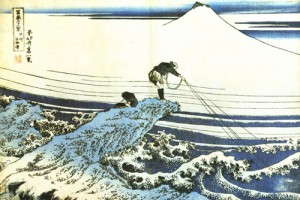 (HOKUSAI IITSU HITSU – In the province of Kai) the general public gets more familiar with the Japanese culture during the Universal exhibition of 1878, while the large collections of the specialists in Japanese studies of the first hour are constituted, those of the men of letters Charles Baudelaire, Philippe Burty, Jules Champfleury, Émile Zola and Goncourt, travellers Enrico Cernuschi, Theodore Duret and Emile Guimet, industrialists like Charles Haviland, jewellers like Henri Vever, the engravers and the painters Felix Bracquemond, Carolus Durand, Edgar Degas, Fantin-Latour, Charles Gillot, Edouard Manet, Manzi, Henri Tissot and Monet. Burty wrote : “Japan has just gained with the Universal exhibition in the double forms of its arts and its industries of formerly and today a complete and decisive victory.
(HOKUSAI IITSU HITSU – In the province of Kai) the general public gets more familiar with the Japanese culture during the Universal exhibition of 1878, while the large collections of the specialists in Japanese studies of the first hour are constituted, those of the men of letters Charles Baudelaire, Philippe Burty, Jules Champfleury, Émile Zola and Goncourt, travellers Enrico Cernuschi, Theodore Duret and Emile Guimet, industrialists like Charles Haviland, jewellers like Henri Vever, the engravers and the painters Felix Bracquemond, Carolus Durand, Edgar Degas, Fantin-Latour, Charles Gillot, Edouard Manet, Manzi, Henri Tissot and Monet. Burty wrote : “Japan has just gained with the Universal exhibition in the double forms of its arts and its industries of formerly and today a complete and decisive victory.
Monet, settled in the countryside, follows closely these Parisian demonstrations as is demonstrated in a letter addressed to Paul Durand-Ruel :” the opening of the Japanese fair is not Tuesday, but tomorrow Monday. I will then come tomorrow”. It was a retrospective organized by Louis Gonse, in 1883, at the gallery Georges Petit, including three thousand paintings of prints coming from Parisian private collections. In 1890, the Japanese print triumphs with the exhibition of the Fine Art School, which offers a complete overview of Uklyo-e, from the origins to 1860. At these great retrospectives, of which we only mention the most important, succeed exhibits showing individuals such as Utamaro and Hiroshige, at the Durand-Ruel gallery, in 1893. Exhibitions which fascinated impressionists Monet and Pissaro. The latter confides to his son Lucien : “Admirable, the Japanese exhibition. Hiroshige is a marvelous impressionist. Me, Monet and Rodin are filled with enthusiasm (…) these Japanese artists confirm to me our visual position”. Perhaps Monet purchased, on this occasion, engravings of Utamaro and Hiroshige.
Travel Books
The reopening of Japan to the Westerners offers the occasion to the French to explore this country and to bring back items. Thus, Charles Chassiron, Cernuschi, Duret and Philippe Sichel tell their travel souvenirs in high color books, which take place in the libraries of the specialists in Japanese .On this point Edmond de Goncourt writes in his diary : “ Basically, thanks to the trip of Philippe Sichel and later the trip of Bing, Europe met Japan and they popularized the art of the Empire of the Sun in Occident”.
However, the Goncourts or Philippe Burty have a rich documentation on the history, customs, literature and arts of this country. The library of Monet in Giverny contains still today the works of Duret, Henri Focillon and Gustave Migeon, dedicated to the painter. Studies of Bing, Goncourt and Revon reveal his interest for Hokusai, but also the importance of the monographs devoted to Hokusai, engraver.
Shops
Monet probably often visits, like his friends, these shops already specialized in the products of the Far East, recently converted into the importation of Japanese objects. Merchants Decelle, at the name of
the Chinese emperor and Bouillette with the Chinese Gate, salesmen of tea, post at the front window of the street Vivienne: “articles from China, India and Japan”. Thus, from the opening of their shop in 1863, Mister and Mrs Desoye specialize in Japanese art and sell illustrated albums which fill with wonder Baudelaire. To respond to an increasingly pressing request, other stores open in 1870 and their owners Samuel Bing and Philippe Sichel undertake, like Desoye, the distant travel to the country of the Rising sun in search of abundant and cheap goods. Sichel tells with eloquence “this hunting for the object”, in his book “Notes of a knickknack man in Japan”. Very quickly some Japanese, having guessed the importance of this market, establish some branches in Paris exporting from Tokyo or Yokohama, as Mitsui and Co, Wakai and Hayashi.
TADAMASA HAYASHI
Blanche Hoschedé, the daughter-in-law of Monet, reports that the Japanese merchant Tadamasa Hayashi often payed a visit to the painter of Giverny. Arriving in Paris at the occasion of the Universal exhibition from 1878, Hayashi then works on behalf of the Kiritsu firm, charged by the Taikoun government to organize the Japanese section. He creates, with Oyaji Wakai, a business which deals with importation of items and prints of the country of the Rising sun. In 1890, he settles 65 rue de la Victoire , self-employed, and appears in the Didot-Bottin as : objects of art from Japan, Expert assessment and informations for museums and collections. Hayashi makes friends with Monet and the other collectors and teaches them the mysteries of Japanese art. He collaborates closely to the books Outamaro and Hokousai, written by Edmond de Goncourt, by getting translations of Japanese texts and innumerable informations. Louis Gonse, also, calls on his services for his book “Japanese art”.
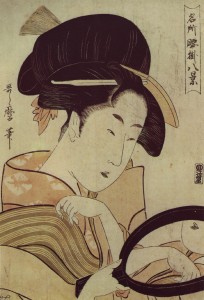 (UTAMARO HITSU – Woman with the mirror) Tireless traveler, over the course of eleven years, he travels a lot between France and Japan, receives two hundred and eighteen deliveries from Japan by French boats from Yokohama. He imports 156487 Japanese prints, excluding the inro (drug boxes), the lacquers, the sabers’ sheath and other objects.
(UTAMARO HITSU – Woman with the mirror) Tireless traveler, over the course of eleven years, he travels a lot between France and Japan, receives two hundred and eighteen deliveries from Japan by French boats from Yokohama. He imports 156487 Japanese prints, excluding the inro (drug boxes), the lacquers, the sabers’ sheath and other objects.
But Hayashi does not limit himself in his role of merchant of Japanese art, he is also fascinated by the French art and in particular by the impressionists, of which he collects works. He buys two paintings of Monet: Rock coasts. Rocks of the Lion, Belle-Ile (Wildenstein, 1090) and young girl in the garden of Giverny (Wildenstein, 1207) in exchange for prints of Utamaro, Eishi and Hokusai stamped by his seal and which still appears in the collection of Monet.
This theory of an exchange was confirmed in the testimony of Raymond Koechlin, to whom Monet showed very beautiful prints and potteries swapped for paintings.
Moreover this practice seems rather current, as Vincent van Gogh write to his brother Theo : “ you”ll get a Claude Monet and other paintings, if you struggle to find some crepe papers, you have the right to swap for them.
In 1893, Hayashi organizes in Tokyo the first exhibition of impressionist painters. Appointed commissioner of the Universal exhibition from 1900 in Paris, he must give up any mercantile activity and takes care of the splendid edition of “history of the art of Japan”, published on this occasion.
After twenty-three years spent in France, he went back to his country. One of his most dear desires is to make a gift of his collection of impressionists to the museum of Tokyo, so that his compatriots can familiarize themselves with this art. Unfortunately he dies in 1906 before having been able to successfully complete his project.
KOJIRO MATSUKATA
Among the Japanese friends of the painter there is Kojiro Matsukata, a businessman who arrived in France in 1920, He is interested in the impressionists and in particular in Monet, acquiring twenty-five of his paintings. Familiar with Giverny, he is photographed on the Japanese bridge at Monet’s house, with the painter and his niece Mrs Furoki, by his side, dressed in a kimono. Author of a splendid collection of Japanese prints which constitute today the funds of the National museum of Tokyo, he also wants to create in Japan a museum for his collection of impressionist works. Unfortunately, his dream did not become reality, as a part of its collection was sequestrated by the French government in 1944, and given back to Japan in 1959, eight years after his death. Hayashi and Matsukata bring to Monet their knowledge of Japan and of his art. But they are also active admirers of the French painter, they make known his work in their country. Thanks to them the Japanese museums have many paintings of Monet, and he is one of the French painters most appreciated by the Japanese public. We can see the importance of the merchants in the diffusion of Japanese art but the contribution of the friendly collectors should be remembered,
THÉODORE DURET
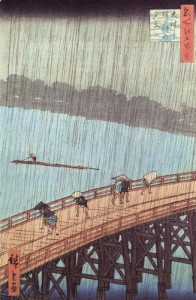 (HIROSHIGE GA – Rain) In 1873, through Camille Pissarro, Monet got to know the critic and collector Theodore Duret, who brings to him a personal vision of Japan and new points of view. Stemming from a comfortable family and successor of a cognac mark, Duret begins his career as chairman viticultural Company of Charentes. Republican, he supports the federate, and is forced in 1871, to expatriate himself with his friend Cernuschi to escape the firing squad. He visits the Far East and remains lengthily in Japan, which he already had explored in 1863. This globe trotter reports many memories, recorded in his book “Voyage in Asia”. When he gets back he is obligingly surrounded by the specialists in Japanese, captivated by his stories and the illustrated albums he brought back. He develops his thoughts on the art of the Empire of the Rising sun in an article of the Criticism of Avant-garde (1885), a book he offers to Monet with a dedication.
(HIROSHIGE GA – Rain) In 1873, through Camille Pissarro, Monet got to know the critic and collector Theodore Duret, who brings to him a personal vision of Japan and new points of view. Stemming from a comfortable family and successor of a cognac mark, Duret begins his career as chairman viticultural Company of Charentes. Republican, he supports the federate, and is forced in 1871, to expatriate himself with his friend Cernuschi to escape the firing squad. He visits the Far East and remains lengthily in Japan, which he already had explored in 1863. This globe trotter reports many memories, recorded in his book “Voyage in Asia”. When he gets back he is obligingly surrounded by the specialists in Japanese, captivated by his stories and the illustrated albums he brought back. He develops his thoughts on the art of the Empire of the Rising sun in an article of the Criticism of Avant-garde (1885), a book he offers to Monet with a dedication.
Enriched by his discussions on painting with Manet, Pissarro and Monet, he analyzes the prints ukiyo-e according to “the impressionist vision”: “Japanese, them, did not see nature in mourning and in the shadow, on the contrary, it appeared to them colored and full with clearness”.
His stay in Japan allowed him to describe the objects in their function, defining the lifestyle of the Japanese. His point of view is of course partial but right; it moves away from a definition of Japanese art until then purely formal. His library of Japanese illustrated albums, today still one of the most important of Europe (at the National library since 1900), is to be brought closer, all things considered, of the one of Monet (Marmottan Museum). Its detailed description of the “Manga” and the “Hundred sights of Fuji” d’ Hokusai together with the books of Hiroshige perhaps encouraged Monet to acquire albums.
GUSTAVE GEFFROY
Defender of his painting without knowing him, the art critic Gustave Geffroy meets Monet by chance in Belle-Ile in 1886. He, at that time, uses his pen to the artistic Japan of Bing and dedicates two articles to the Japanese Landscape designers.
Japan being revealed to him in the writings and the stories, he gives a literary and magical vision of it, comparing this country to a miniature garden wrapped into luminous air and Japanese art with the history of its landscape. Comparing the two Masters of the landscape ukiyo-e, he defines Hiroshige as, an imaginary artist [ .. ] intended for immediate popularity” and gives his preference to Hokusai , he describes as “poet of another scale”. Painter of customs, friend of the Goncourt, he becomes president of their academy.
He receives from Edmond, in 1890, an album of the Manga (collection of drawings of Hokusai) and thanks him in these terms: “It is an exquisite gift, I am infinitely grateful. Drawings of Hokusai and a so affectionate dedication of Edmond de Goncourt, it makes me happy. Thanks to you, I have Japan at home, and a charming memory of your friendship”. Key character by the position he has in the literary and arts world, Geffroy belongs to this sphere of specialists in Japanese, of which Monet is one of the participants.
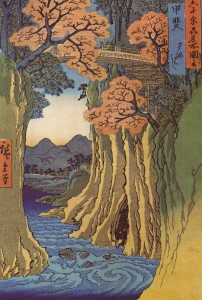 GEORGES CLEMENCEAU
GEORGES CLEMENCEAU
(HIROSHIGE HITSU – The bridge of the monkey) Co-worker in the newspaper “La justice” of Georges Clémenceau, Geffroy renew links between the politician and the painter of Giverny. Man of culture, passionate of Greek art and objects of the Far East, Clemenceau gather, thanks to his friend Francis Steenackers, consul in Yokohama, a set of three thousand five hundreds Kogo (perfume boxes). He also has Japanese prints which some (two Harunobu, two Utamaro, one Sharaku and some Hiroshige) worthy to appear in the exhibition of 1890 (School of the Art schools).
In 1891, on his initiative, the Museum of Louvre buys two Japanese statues, premise of a department of Japanese art. Today, the few prints preserved in the Parisian apartment of Clemenceau, Franklin street, are next to the painting of his “ old brother “ (Monet): Le bloc (Wildenstein, 1228).
RAYMOND KOECHLIN
The first meeting between Claude Monet and the collector Raymond Koechlin took place in 1897, in the private room of the gallery Georges Petit, at the time of the sale of paintings from the Henri Vever’s collection, during which some Monet, Pissaro and Sisley are dispersed. This Alsacian historian, of comfortable family, incarnates the expert in the broadest sense of the term.
Passionate by Japanese, Chinese and Moslem, French, Middle Ages or impressionist arts, he has the “love at first sight” for the prints with the exhibition of 1890 at the School of the Art, and testifies his enthusiasm for the art ukiyo-e in the preface he writes at the time of the prestigious events of the Museum of decorative Arts. He gather beautiful engravings by the intermediary of Hayashi and reports with humor his first meeting with the merchant in his book : “Souvenirs of an old art lover of the Far East” (1930). Man of museums, he gives in 1902 a part of his prints to the Decorative Arts Muséum and bequeaths into 1931 some “primitive” engravings, of Hokusai and Hiroshige to the Museum of Louvre. The origin of the friendship of Duret, Geffroy, Clemenceau and Koechlin for Monet and the privileged link which links them with the painter is more in their admiration for his work and its personality that in their common passion for the prints.
They all are enthusiastic defenders of the painting of Monet even when he met critic of the public
and the incomprehension of criticisms.
Extracted from the book “the collection of Japanese prints of C. Monet” © Genevieve AITKEN and Marianne DELAFOND
Translated by Sandrine CHIFMAN

 English
English Français
Français 